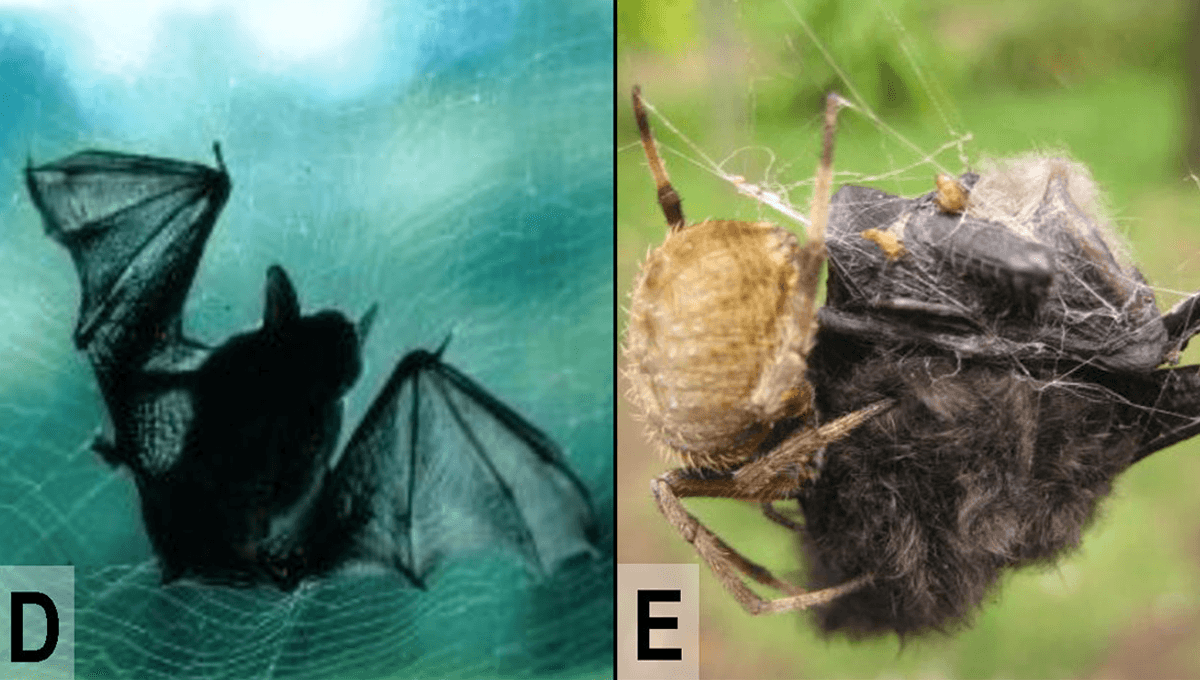
If you’re interested in bats, there’s a good chance you know that around 70 percent of bat species are insectivores, some capable of consuming hundreds of insects an hour, some gobbling down up to a third of their body weight during a single night of hunting. Some species even eat spiders, though it is not their primary food source. But it turns out spiders, perhaps in solidarity with their evolutionary cousins, are capable of flipping the tables every once in a while and consuming bats.
In the past, spiders have been observed to consume dead bats, but this was assumed to be an act of necrophagy, consuming the corpses of animals that had not been killed by the spiders themselves. But in 2013, a paper titled simply “Bat Predation by Spiders” documented “at least 50 incidences” of spiders capturing and consuming bats. Compiling reports from the literature, the team found that bats had been predated on by spiders on every continent of the world, except Antarctica.
So, what kind of spiders are we talking about?
“Bat-catching spiders belong to the araneomorph families Nephilidae (golden silk orb-weavers), Araneidae (orb-weaver spiders), Sparassidae (huntsman spiders), and the mygalomorph family Theraphosidae (tarantulas),” the paper explains. “Furthermore, an attack attempt by an araneomorph hunting spider of the family Pisauridae (fishing spiders) was witnessed. Seventy-three percent of the known incidences of bat catches were attributable to orb-weaving spiders, 15% to unidentified web-building spiders, and 12% to hunting spiders.”
The spider earning the top spot in the “most consumed bats” category went to the giant orb-weavers of the genus Nephila (Nephilidae). This is perhaps unsurprising, given the strength of their webs.
“We found that golden orb spiders produce particularly tough silk and the larger spiders from the rainforest, which can grow up to 20cm in diameter, produce the strongest yet thinnest silks,” Genevieve Kerr from the University of the Sunshine Coast told Australian Geographic, explaining that the outer frame, known as “dragline silk,” gave the webbing its strength.
“Made from major ampullate silk, it has a unique combination of strength and extensibility resulting in a fibre that is tougher than any man-made material.”
With these webs, certain species of giant orb-weavers have been observed to capture and consume bats.
“On certain locations, where females aggregate, several webs are built connected to each other, which may result in a web area of many square meters,” the paper explains. “Of the 15 valid species in the genus Nephila, only two species – namely Nephila clavipes and Nephila pilipes – have been reported so far to be engaged in bat catching. It can be assumed, however, that other Nephila spp. catch bats as well. “
Tarantulas, as well as hunting spiders, have also been observed consuming bats. There have also been observations of bats finding themselves caught up in a web and dying, but not being consumed by their captor. It should be noted that it is unclear whether all the incidents of bat consumption are predation or simply taking advantage of an accidental capture.
“Some of the bats entangled in spider webs are actively killed and consumed by the spiders (i.e., predation), whereas in other instances the entangled bats are not consumed by the spiders (i.e., non-predation deaths),” the team noted. “In several of the incidences, where dead bats were found suspended in spider webs, it could not be determined whether predation had taken place because of the bats’ desiccated condition.”
Other times, spiders have been seen attempting to kill bats before becoming camera-shy.
“An attempt by a large fishing spider Dolomedes triton (Pisauridae) to kill a bat pup has been witnessed below a bridge in Indiana, USA. However, in this latter case, the predation attempt failed probably because the spider was frightened by the presence of the photographing observers.”
In a more recent study, a false widow in the UK had been found to kill and eat a small bat pup.
Though it is difficult to imagine spiders preying on such comparably large mammals, perhaps it’s not all that surprising.
“The observation of bat-catching by spiders is not that peculiar if we consider the fact that a number of larger-sized spiders are known to supplement their arthropod diet by occasionally preying on vertebrates. Fishing spiders (Pisauridae) have been reported capturing and devouring fish and frogs,” the team wrote.
Source Link: There Have Been At Least 50 Incidents Of Spiders Capturing And Eating Bats (That We Know Of)